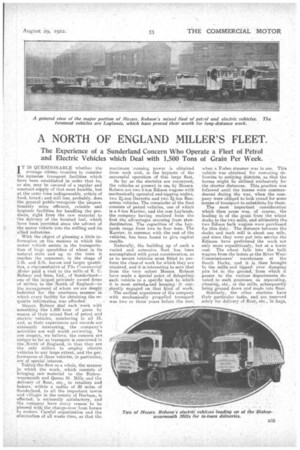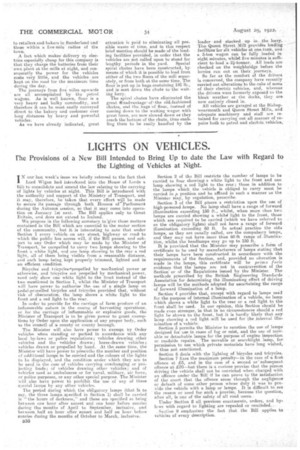A NORTH OF ENGLAND MILLER'S FLEET.
Page 19

Page 20

If you've noticed an error in this article please click here to report it so we can fix it.
The Experience of a Sunderland Concern Who Operate a Fleet of Petrol and Electric Vehicles which Deal with 1,500 Tons of Grain Per Week.
T IS QUESTIONABLE whether the I. average citizen troubles to consider the immense transport facilities which have been established in order that he, or she, may be assured of a regular and constant supply of that most humble, but at the same time indispensable, article of food, bread ; and still less, probably, does the general ptiblic,reeognize the unquestionably more efficient, reliable and hygienic facilities for handling the products, right from the raw material to the delivery of the finished loaf, which have been provided since the advent of the motor vehicle into the milling and its allied industries.
With the object of gleaning a little inform4ion on the manner in which the motor vehicle assists in the transportation of huge quantities of wheat in its natural state and up to the time it reaches the censumer, in the shape of 1-lb. and 2-lb. loaves and larger (pangties, a representative of rho!. Commercial Motor paid a. visit to the mills-of E. C: _Robson and Sons, Ltd., of Sturiderland one of the largest privately invned firths of Millers in tha"North of England—to the assuagement of whom we are deeply indebted for The .conou.s manner in which every facility for Obtaining the requisite information was afforded.
Messrs. Robion deal each week with something like 1,500 tong of grain by means of their mixed fleet of petrol and electric vehicles, numbering in all 15,. and, as their experiences and records are extremely interesting; the company's activities are well worth %reviewing. In one respect,_ we believe, -the concern are unique so far as transport is concerned in the North of England, in that they are the only millers to employ electrje vehicles to any large extent, and the performances of these vehicles, in particular, are of special interest Taking' the fleet as a whole, the manner in which the work, .which consists of bringing raw material to the Bishopwearmouth and .Queen St. Mills and the delivery of flour, eta.. to retailers and bakers, within a radias of '30 miles of Sunderland, to all the important towns and villages in the county of Durham, is effected, is eminently satisfactory, and the company have every reason to be pleased with the change-over from horses to motors. Careful organization and the elimination of all waste time, so that the
maximum running power is obtained from each unit, is the keynote of the successful operation of this large fleet.
So far as the electrics are concerned, the vehicles at present in use by Messrs. Robson are two 5-ton Edison wagons with mechanically operated end-tipping bodies, two 4-ten Garretts and two 3-ton Ran comesvehicles. The remainder of the fleet consists of petrol' vehicles, one of which is a 4-ton Karrier, and the rest Le-viands, thecompany having realized from the first the advantages accruing from standardization. The capacities of the Ley: lands range from two to four tons. The Karrier, in common with the rest of the vehicles, has been found to give capital results.
Naturally, the building tip of such a varied and extensive fleet has been accomplished with great consideration, so as to secure vehicles most fitted to perform the class-of work for which they are required, and it. is interesting to note that from the very outset Messrs. Robson have made a special point of delegating each vehicle to a specific task to which it is most. suiteclosand keeping it conStaidly engaged' on that kind of work.
The earliest experience of the company with mechanically propelled transport was two or three years lacfote the war, • when a Foden steamer was in.use. This vehicle was obtained for executing de. liveries to outlying districts, so that the horses might be utilized exclusively for the shorter distances. This practice was followed until the horses were commandeered during the war, when the company were obliged to look round for some means of transport to substitute for them. .
The most important consideration which then arose was, of course, the leading in of the grain from the wheat docks to the two mills, and ultimately the two Edison bulk wagons were purchased for this duty. The distance between the docks and each mill is about one mile, and since they were put into service the Edisons have performed the work not only more expeditiously, tint at. a lower • cost. The wheat falls into the bulk wagons frorn.the hoists at the River Wear Commissioners' warehouses at the South Docks, and it is then brought to the mina and tipped over dumping pits let in the ground, from which it passes to the various departments devoted to such, processes as separating, cleaning, ete.; at the mills, subsequently being ground down and made into flour.
Sirnilari, the other electric.% have their particular tasks, and are reserved solely for delivery of flour, etc., in bags, to retailers and.bakers in Sunderland and those within a five-mile radius of the town.
A fact which makes delivery oy electries especially cheap for this company is that they charge the batteries from their own plant at the mills at night, and consequently the power for the vehicles costs very little, and the vehicles are kept on the road for the maximum time during the day.
The journeys from five miles upwards are all accomplished by the petrol wagons, As is well known, flour is a very heavy and bulky commodity, and therefore it can be most easily conveyed direct to the bakery and customer over long distances by heavy and powerful vehicles.
hes we have already indicated, great attention is paid to eliminating all possible waste of time, and in this respect brief mention should be made of the loading facilities provided, in order that the vehicles are not called upon to stand for lengthy periods in the yard. Special spiral chutes have been constructed, by means of which it is possible to load from either of the two floors of the mill separately, or from both at the same time. The flour is put up in bags containing 140 lb., and is sent dOwn the chute to the waiting lorry. The spiral chutes have eliminated the great disadvantage•of the old-fashioned chutes, and the.hags of flour, instead of coming down to the waiting wagon with great force, are now slowed down as they reach the bottom of the chute, thus enabling them to be easily handled by the
loader and stacked up in the lorry. The Queen Street Mill provides leading facilities for sill :vehicles at oneetenfe, and a 5-ton wagon can be hilly .loaded in eight minutes, whilst five minutes is sufficient to-load a-2i-tonner. All leads are checked on the weighbridge before the lorries run out on their journeys.
So far as the conifort of the drivers is concerned, the company have recently carried out alterations to the cabs of some of their electric vehicles, and, whereas the drivers were formerly exposed to the bleak weather at the docks, they are now entirely closed in. • All vehicles are garaged at the Bishopwearmouth and Queen Street Mills, and adequate machinery and staff are retained for carrying out all manner of repairs both to petrol and electric, vehicles,




























